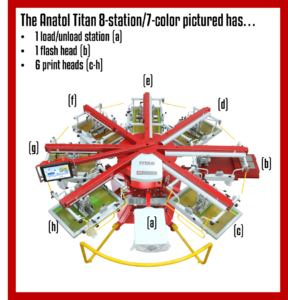

Revolutionizing the screen printing industry through cutting-edge technology and quality service
Anatol Equipment Manufacturing Co.
1429 S Shields Dr
Waukegan, IL 60085


Revolutionizing the screen printing industry through cutting-edge technology and quality service
Anatol Equipment Manufacturing Co.
1429 S Shields Dr
Waukegan, IL 60085

This might seem like a fairly straightforward choice, but there are a few big factors that are easy to overlook, especially if you’re a first-time buyer.
As you browse your equipment options, you’ll notice that screen printing presses (both manual and automatic) are listed by how many colors and how many stations the machines have. Let’s take a closer look at what these terms mean.
The number of colors really refers to the number of heads on the machine. The heads are the assemblies that hold either the squeegees, flood bars and screens, or that hold the flash cures. While the number of colors does correspond to the number of colors it is technically possible to print, in practice there may be some limitations. If your design does not require an underbase or flash curing, you can actually print 5 colors on a 5-color screen printing press. However, if your print requires an underbase and flash curing, it’ll reduce the amount of colors you’re able to print.
Consider this: You want to print a yellow, blue and red design on a black shirt. That’s 3 colors, so all you need is a 3-color press, right? Let’s see…
In order to get a print with vibrant colors on a dark garment, you first need to lay down a white underbase. That underbase requires a dedicated print head.
Before you can print the yellow, red and blue layers on top, you must flash the underbase. Most flash cures also require a dedicated head. Now, 2 of the heads on your machine are already occupied just to set up the foundation of your print. You haven’t even started printing colors yet.
Next, the yellow, red and blue colors will require their own print heads. So what you might think of as a 3-color job actually requires a machine with at least 5 heads. You may also need to use an additional head as a cool-down station after flash curing your underbase to prevent issues when printing the subsequent layers of ink.
It’s easy to overlook that some of the heads on the machine will need to be dedicated to underbase and flash cures, instead of colored ink. Take this into account especially if you plan on tackling four color process jobs. A 4-color press – contrary to its name – does not have enough heads to accommodate four color process printing under most circumstances.
The number of stations refers to the number of pallets the machine holds – or the maximum number of shirts that can be on the machine at any given time. The pallets are attached to the rotating carousel that moves shirts under the heads. The number of stations equals the number of colors (heads), plus any additional stations without a head where you can load and unload shirts. Some manual screen printing machines are available in “all-heads-down” configurations, which means the number of colors is the same as the number of stations. This allows multiple operators to print on all stations of the machine simultaneously.

On an automatic press, there will always be more stations than there are colors. These stations are for loading and unloading shirts. Some automatic screen printing machines (like the one pictured above) have one more station than colors – one station for both unloading and loading shirts. Other presses have separate stations for loading and unloading. If you plan on having only one operator load and unload shirts, one station should be enough for both tasks. It can speed up your production having one worker load shirts while another unloads them. In this case, you’d need separate load and unload stations. Some presses are available with an option to raise one of the print heads, giving you the ability to use that station for either unloading or printing.
Machines are available in so many configurations, how do you choose what size you need? It’s always a good idea to buy as large of a press as you can reasonably afford (without going overboard – think about what your average print job looks like, and how you’d like to expand your capabilities). An extra print head or two will give you more versatility and allow you to take on more intricate designs. When you shop for a press, don’t only consider your present requirements. Remember that a screen printing press is an investment. You don’t want to buy a machine that you’ll quickly outgrow. Instead, you want to choose a machine that you can grow into.
As always when shopping for new equipment, keep your available space in mind. The diameter of a press increases with the number of colors and stations, so you need to be sure whatever configuration you choose will fit in your shop with a couple of extra feet all the way around in which operators can work safely. Additional heads also require more electricity and/or air to power them, so make sure your shop is capable of handling the power requirements of the machine.
Looking for more tips on finding the right press for your shop? Take a look at these blogs:
A Beginner’s Guide to Buying an Automatic Screen Printing Press
Getting Started With Your First Manual Screen Printing Press
Are You Ready for an Automatic Screen Printing Press?
Or check out our Compare Presses tool to see side-by-side comparisons of Anatol’s automatic presses.
Your message was successfully sent!